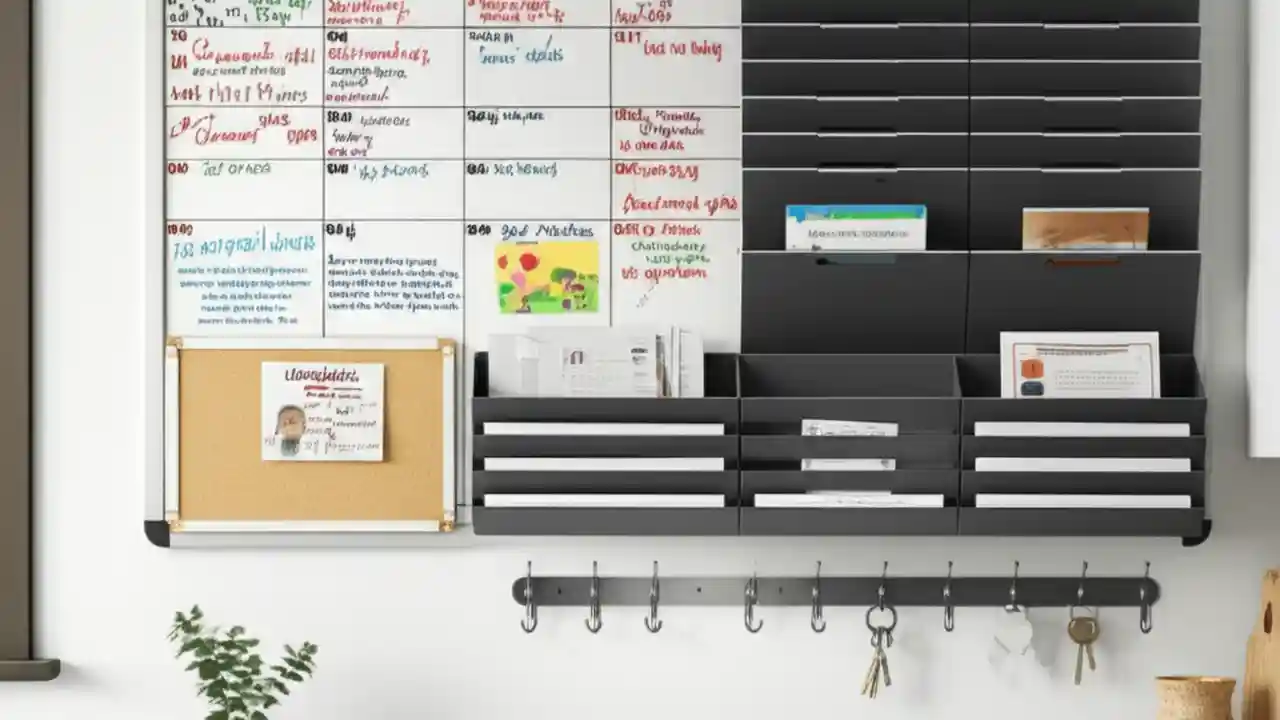The absolute best system for organizing your mail is a simple, two-part strategy: a daily sorting routine combined with a long-term, easy-to-access filing method. For most people, this means using a “Touch It Once” approach with a four-tray system for daily paper mail and a streamlined “Delete, Delegate, Do” method for conquering your email inbox. It’s not about finding a complex, perfect system; it’s about creating a simple, sustainable habit that eliminates clutter for good.
If you’re reading this, chances are you’re feeling overwhelmed. Mail piles up on the kitchen counter, your email inbox has a four-digit unread count, and the thought of tackling it is exhausting. I get it. Over my 20 years helping people and businesses create order from chaos, I’ve seen it all. The key isn’t a magic wand, but a practical, step-by-step framework that turns a mountain of mess into a manageable molehill.
In this guide, we’ll walk through creating a foolproof system for both your physical and digital mail. We’ll cover everything from setting up your “command center” and tackling that scary backlog to the exact document retention schedules you need. We’ll even explore the best tools for the job in 2025, so you can finally achieve a permanently organized mailbox and inbox.
Table of Contents
Getting Started: Your Mail Command Center
Before you can implement a system, you need a dedicated space to run it. Trying to sort mail on the same counter where you make dinner is a recipe for disaster. A command center is your home base for all things mail-related, and setting one up is the first real step toward control.
What’s the First Step to Taming Mail Chaos?
The first step is to stop the bleeding. Designate one, and only one, spot for all new, unsorted mail. This could be a specific basket, a tray, or a spot on your desk. From this moment forward, no mail gets dropped anywhere else. This simple act contains the problem and prevents it from spreading throughout your home.
Don’t try to sort your entire backlog at once. That’s a classic mistake that leads to burnout. We’ll get to the backlog later. For now, your only job is to corral all *new* mail into your designated spot. This is a small, achievable win that builds momentum.
How Do I Set Up a Mail Organizing Station?
Your mail station doesn’t need to be fancy, but it does need to be functional. Find a small corner in your home office, kitchen, or near the entryway. Here are the essential tools to have within arm’s reach:
- Inbox Tray: A single tray for all incoming, unprocessed mail. This is the “stop the bleeding” spot we just discussed.
- Action Trays/Folders: At least three more vertical or stacking trays. We’ll discuss what goes in them shortly, but label them clearly: To-Do, To-File, and To-Shred.
- Paper Shredder: Non-negotiable for protecting your identity. A cross-cut or micro-cut shredder is best. Keep it right next to your sorting area so you can shred junk mail immediately.
- Recycling Bin: For envelopes, flyers, and non-sensitive junk mail.
- Basic Supplies: A pen, a letter opener, stamps, and envelopes for outgoing mail.
- Digital Scanner (Optional but Recommended): A small desktop scanner or even a good scanning app on your phone can be a game-changer for going paperless with key documents.
Having everything in one place removes friction. When it only takes 30 seconds to open, decide, and act on a piece of mail, you’re far more likely to do it.
The Ultimate System for Physical Mail
With your command center ready, it’s time for the system itself. This process is designed to be fast, intuitive, and to prevent piles from ever forming again. It’s based on two core principles: “Only Handle It Once” (OHIO) and action-based sorting.
What is the Best Day-to-Day System for Incoming Mail? (The Four-Folder Method)
The goal is to process your mail every single day, or every other day. This daily habit should take less than five minutes. As you pick up each piece from your “Inbox Tray,” you’ll make an immediate decision and place it into one of the following action trays:
- To-Do / Action: This is for mail that requires you to do something. Think bills to pay, invitations to RSVP to, or forms to fill out. The rule is that everything in this tray has a deadline. Schedule a specific time each week (e.g., Sunday afternoon) to clear this tray out.
- To-File: This is for documents you need to keep for your records but require no immediate action. Examples include paid bill confirmations, bank statements, investment reports, or medical records. They sit here until your designated “filing day.”
- To-Shred: This is for anything with sensitive personal information that you don’t need to keep. Credit card offers, expired insurance cards, and old statements go directly here. When the tray is full, have a shredding party.
- Recycle/Trash: Most mail falls here. Junk flyers, catalogs you never read, and empty envelopes go straight into the recycling bin. This doesn’t even need its own tray—just do it immediately.
I had a client who swore by this. He linked the habit to making his evening tea. He’d put the kettle on, and in the two minutes it took to boil, he’d sort the day’s mail into his trays. By the time his tea was ready, his mail was processed. That’s the power of a simple, linked habit.
How Do I Tackle a Massive Backlog of Old Mail?
Seeing a mountain of old mail is paralyzing. The key is to break it down. Don’t try to do it all in one weekend. Instead, use the “Chunk and Purge” method:
- Set a Timer: Grab one box or a manageable pile of mail. Set a timer for just 25 minutes.
- Rapid Sort: Don’t read anything in detail. Quickly sort the pile into three broad categories: Shred/Recycle, Unsure, and Obviously Important (e.g., mail from the IRS, deeds, titles).
- Immediate Purge: At the end of the 25 minutes, immediately shred or recycle everything in that pile. This provides an instant feeling of accomplishment.
- Process the “Unsure”: Take your “Unsure” pile and use the Four-Folder system described above. If you’re not sure how long to keep something, put it in the “To-File” tray for now. We’ll cover retention rules next.
- Repeat: Do one 25-minute session per day until the backlog is gone. It’s amazing how quickly you can clear years of clutter in just a week or two without feeling overwhelmed.
How Long Should I Keep Important Documents? (A Retention Guide)
This is one of the biggest questions people have, and fear of throwing away something important is a major cause of clutter. While rules can vary slightly, this table covers the standard retention guidelines for personal documents in 2025. When in doubt, scanning a digital copy is a great safety net.
| Document Type | How Long to Keep | Reasoning / Notes |
|---|---|---|
| Tax Records & Supporting Documents | 7 years | The IRS generally has up to 3 years to audit, but this can extend to 6-7 years in certain situations. 7 years is the safest bet. |
| Bank & Credit Card Statements | 1 year | Keep for a year for verification, then shred. If a statement supports a tax deduction (e.g., charity), keep it with your tax records. |
| Pay Stubs | 1 year | Keep until you’ve reconciled them with your annual W-2 form. Once your W-2 is correct, you can shred the stubs. |
| Medical Bills & Records | At least 1 year after payment | Keep to dispute any billing errors. For major procedures or chronic conditions, you may want to keep records longer. |
| Home & Auto Records (Deeds, Titles) | Permanently (as long as you own the asset) | These are legal proof of ownership. Keep them in a fireproof safe or safe deposit box. |
| Home Improvement Records | Permanently (until you sell the property) | These can be used to increase your home’s cost basis, potentially reducing capital gains tax when you sell. |
| Warranties & Manuals | As long as you own the item | A simple solution is to scan them or find the PDF online and save it to a cloud folder, then toss the paper. |
How Can I Drastically Reduce Junk Mail?
The best way to organize mail is to have less of it. Stopping junk mail at the source is a crucial step. Here’s how:
- Opt out of prescreened offers: Visit OptOutPrescreen.com, the official service for Equifax, Experian, Innovis, and TransUnion. This will stop the majority of pre-approved credit card and insurance offers.
- Register with DMAchoice: The Data & Marketing Association (DMA) runs a site called DMAchoice.org. For a small fee, you can get your name off the lists of thousands of companies for catalogs, magazine offers, and other mailings.
- Go paperless: Proactively log into your bank, utility, and credit card accounts and switch to paperless billing and statements.
- Contact companies directly: For the catalogs and mailers that still get through, flip to the back, find the customer service number, and call to be removed from their mailing list. It’s a small hassle that pays off forever.
Conquering Your Digital Clutter: The Email Organization System
An overflowing email inbox can be just as stressful as a cluttered countertop. The principles are the same: process quickly, reduce incoming volume, and have a simple system for what’s left. My “aha” moment with email was realizing it’s not a to-do list; it’s a delivery system. Your job is to get things out of the delivery system and into the right place.
What is the “Inbox Zero” Method and Is It Realistic?
Inbox Zero is a concept created by productivity expert Merlin Mann. The goal isn’t necessarily to have zero emails at all times, but to spend zero mental energy on your inbox. It means every email has been processed and moved out of the inbox. For many people, this feels too extreme. I prefer a more forgiving approach I call “Inbox Clean.” The goal is simply to see the bottom of your inbox at the end of each day, even if a few items remain.
How Do I Implement a Simple, Effective Email System? (The 3-D Method)
When you open your inbox, apply the “3-D Method” to every single message, without exception. No reading and leaving it for later.
- Delete/Archive: Is this email just informational, a newsletter I’ve read, or something I’ll never need again? Delete it or, if you’re nervous, archive it. Archiving is your digital safety net—it removes the email from your inbox but keeps it searchable. Be ruthless here; over 80% of your email probably fits this category.
- Delegate: Can someone else handle this? Forward it to the appropriate person, and then move the original email to a “Waiting” folder so you can follow up if needed.
- Do / Defer: Does this email require a reply or action from you?
- If it takes less than 2 minutes: Do it immediately. Reply, confirm, pay the invoice. Get it done and archive the email.
- If it takes more than 2 minutes: Defer it. This is key. Add the task to your actual to-do list or calendar, then move the email out of your inbox and into an “Action” folder. Your inbox is clean, and the task is captured in a system designed for tasks.
What Are the Must-Have Email Folders or Labels?
Don’t recreate your paper filing cabinet with dozens of email folders. It’s slow and unnecessary because your email client’s search function is incredibly powerful. All you need is a minimal set of action-based folders (or labels in Gmail):
- 01 – Action: For emails linked to tasks on your to-do list. Review this folder when you’re planning your day.
- 02 – Waiting: For emails you’ve delegated or are awaiting a response on. Glance at this every few days to see what you need to follow up on.
- 03 – Reference: For things you might need to find later, like flight confirmations, receipts for online orders, or digital manuals.
Everything else? It goes in the main Archive. That’s it. By using the search bar with keywords like “from:American Airlines” or “subject:invoice,” you can find anything in your archive faster than clicking through 50 different folders.
Tools and Technology: Digital vs. Physical
In 2025, we have incredible tools at our disposal. The debate isn’t about choosing one over the other, but about using them intelligently together. A hybrid approach is often the most resilient.
Is a Digital or Physical Filing System Better in 2025?
Both have their place. I recommend a primarily digital system for convenience, backed up by a minimal physical system for critical, original documents. Here’s a quick comparison:
| Feature | Digital Filing System (Cloud-based) | Physical Filing System |
|---|---|---|
| Accessibility | Excellent. Access from anywhere on any device. | Poor. Only accessible where the files are located. |
| Searchability | Instant. Search by keyword, date, or even text within a document (OCR). | Slow. Relies on your memory and folder organization. |
| Security | Good, but vulnerable to data breaches and hacking. Requires strong passwords and 2FA. | Good, but vulnerable to fire, flood, and theft. Requires a fireproof safe for best protection. |
| Space | Takes up zero physical space. | Requires space for a filing cabinet. Can create clutter. |
| Best For | Bank statements, receipts, warranties, reference documents, paid utility bills. | “Life-or-death” documents: birth certificates, passports, social security cards, property deeds, car titles, wills. |
What Are the Best Apps for Scanning and Organizing Documents?
Turning paper into searchable PDFs is a cornerstone of a modern organizing system. You don’t need a bulky office scanner anymore. Your phone is powerful enough.
- Microsoft Lens: Free and fantastic. It integrates perfectly with OneDrive and other Microsoft products. Its OCR (Optical Character Recognition) is excellent, making your scanned PDFs searchable.
- Adobe Scan: Also free and a top contender. It has great edge detection and cleanup tools, and integrates seamlessly into the Adobe ecosystem.
- Evernote Scannable (iOS): If you’re an Evernote user, this is a no-brainer. It’s fast, simple, and automatically files your scans into your Evernote account.
My advice? Pick one, learn it, and use it consistently. The moment a document enters your “To-File” tray, ask yourself: “Can this be scanned and shredded?” If the answer is yes, do it right then and there.
Building a Lasting Habit
The best system in the world is useless if you don’t use it. The final, and most important, piece of the puzzle is turning these actions into an automatic, unconscious habit.
How Do I Make Mail Organization a Sustainable Habit?
The secret is habit stacking. Anchor the new, tiny habit of sorting your mail to an existing, solid habit you already do every day.
Some examples:
- “After I put my keys in the bowl, I will immediately walk my mail to the command center.”
- “While my morning coffee is brewing, I will sort yesterday’s mail.”
- “Right after I shut down my computer for the day, I will process my email inbox using the 3-D method.”
Start ridiculously small. Commit to processing just one piece of mail or one email. The goal is to make the act of starting so easy you can’t say no. Consistency is infinitely more powerful than intensity.
What if I Fall Off the Wagon?
You will. Life happens. You’ll go on vacation, get sick, or have a crazy week at work, and you’ll come home to a pile of mail and a full inbox. It’s not a failure; it’s a test of your system’s resilience.
Don’t beat yourself up. Just do a quick reset. Schedule 30 minutes, put on some music, and run through the system. Process the physical mail using your four trays. Process your email using the 3-D method. Because you have a system to fall back on, recovering takes minutes, not days. The goal isn’t perfection; it’s progress and a reliable plan for when things get messy.
Conclusion
The best system for organizing your mail isn’t a single product or a rigid, complicated workflow. It’s a simple, two-pronged approach: manage daily intake with an immediate “Touch It Once” sorting method, and support it with a clear, minimal filing structure for long-term storage. By setting up a command center and linking this quick daily task to an existing habit, you transform mail from a source of stress into a simple, thoughtless routine.
Remember, the aim is to make quick decisions to clear your counters and your mind. Whether you use the Four-Folder system for paper or the 3-D method for email, consistency will always win over intensity. Start today, start small, and reclaim your space from the clutter. If this guide helped you, consider sharing it with someone else who’s feeling overwhelmed!









